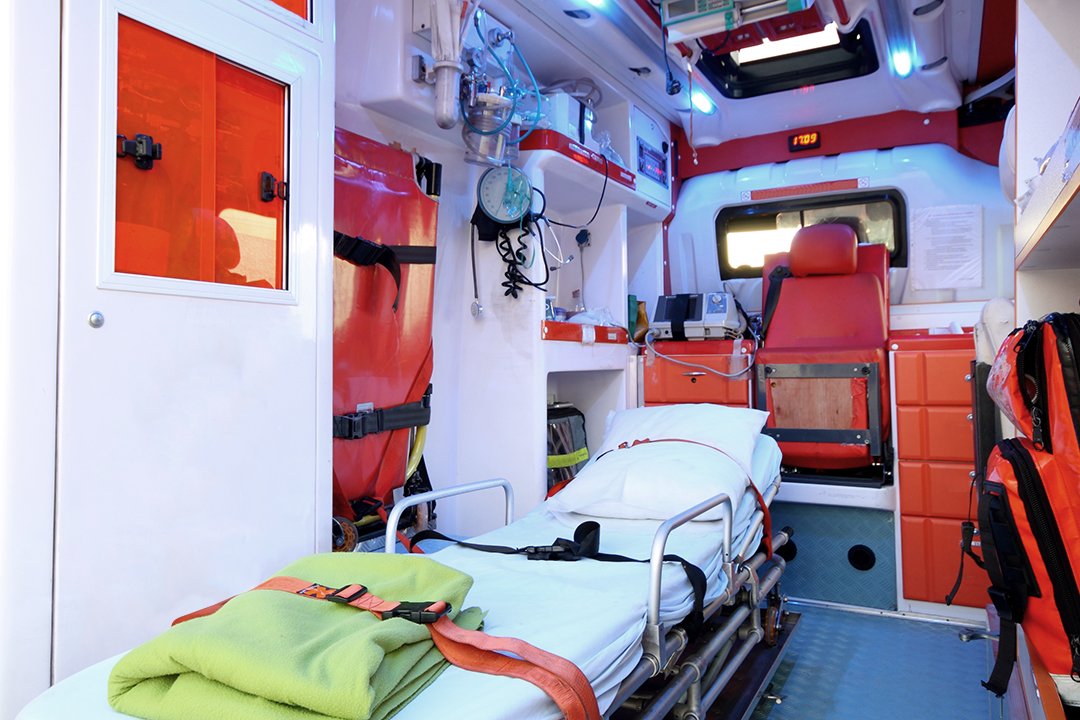Transfer to a hospice in an ambulance aircraft
Reading Time: 4 minutes
Table of contents
When a serious illness can no longer be cured, many patients want to spend their last weeks or months in a dignified setting, with good medical care. A stay in a hospice is an excellent option for such patients because they will be well cared for in every respect.

However, not everyone wants to be transferred to their nearest hospice. Proximity to family members, a final reunion with their home town, or a lack of places in a hospice close by can lead the patient to decide on a hospice that’s further away from their home. In order to get there safely despite the patient’s advanced illness, an ambulance flight is often the best solution.
Advantages of an ambulance aircraft
An ambulance aircraft has two key advantages: it can be quickly readied for deployment anywhere in the world and offers excellent medical facilities for transporting patients. It often takes only a few hours to have an ambulance jet ready and waiting at an airport of your choice. This also includes smaller regional airports, which would not be available for a scheduled airliner. This allows the palliative care patient to be transferred quickly and means they will arrive very close to their chosen hospice, even if it is not near a major airport.

Every ambulance flight is accompanied by a flight doctor and a nurse. This ensures optimal medical and nursing care for the patient. The technical equipment on board an ambulance aircraft offers conditions similar to those of a modern intensive care unit. For some hospice patients, intensive medical care is not necessary at the time they are travelling. But it is reassuring for patients and relatives alike, that if there is an emergency during the flight, appropriate treatment options are available on board.
Are there any alternatives?
If a hospice patient needs to make a long journey, they can also travel in a scheduled aircraft, an ambulance helicopter or an ambulance vehicle. However, these means of transport can only be used if circumstances permit.
Scheduled airliner
If the palliative care patient’s state of health is such that they can still take a scheduled flight, the flight can be medically accompanied. A doctor or paramedic is assigned to the patient and carries emergency medical equipment on board. This allows them to intervene immediately if necessary. The patient travels either seated in Business Class, to allow the medical support person the best possible freedom of movement, or lying on a patient bed, specially installed for that flight.

Compared to an ambulance aircraft, there are clear advantages and disadvantages. Medically accompanied transport in a scheduled aircraft is more cost-effective but offers considerably less flexibility. Only existing flight routes can be followed – and usually only direct connections, as changing planes generally puts too much stress on patients. This means that the patient will arrive at a major international airport and may still have to make a long road journey to the hospice.
In addition, airlines usually require a lead time of at least 1–2 days to check the patient's fitness to fly, based on the information in their file. As palliative patients have little time left to live, this delay is usually not acceptable.
Ambulance Helicopter
Theoretically, an ambulance helicopter could also be used for an ambulance flight to a hospice. In practice, this is only very rarely the case. This is because an ambulance helicopter cannot make use of its greatest advantage when flying to a hospice. While many hospitals have their own landing areas, meaning that a helicopter can take a direct route, a helicopter flying to a hospice would probably have to use the nearest airport. Very few hospices have their own landing areas.
If the medical transport will need to involve using an airport anyway, then an ambulance aircraft is the better alternative. Even though both may have comparable medical facilities, a helicopter is slower, more expensive and has a shorter range. Therefore, using an ambulance helicopter only makes sense in a few exceptional cases.
Ambulance

While a ground ambulance is a serious option for short distances, it is rarely considered for long-distance patient transfers. The medical equipment on board is certainly appropriate for transporting patients, but travelling by road is much slower than travelling by air. In addition, an ambulance is more susceptible to delays, for example due to traffic jams. All of this makes long-distance transport in an ambulance an arduous matter, which is not recommended for palliative patients. After all, the aim of staying in a hospice is for the patient to spend the last days and weeks of their life in a dignified and comfortable manner, and that should also apply to the journey to the hospice.
Will the health insurer pay for the patient’s flight to the hospice?
While, in Germany, a large portion of the cost of a stay in a hospice will be covered by the patient’s statutory health insurance, this is not usually the case with a long-distance patient transfer. Since the patient’s wish for a transfer to a more distant hospice usually arises from their personal wishes, then, from the point of view of the statutory health insurance fund, there is no need for it to take over the transport costs.
If the transfer to the hospice involves a medical repatriation of the patient from abroad, then the patient’s international health insurance may come into play here. But even in this scenario, the chances of the insurer covering the costs are extremely low. The decisive factor for the insurance company’s decision will be the extent to which the health of the patient may be improved through treatment in their home country. In the case of palliative treatment in a hospice, the possibility of such improvement does not exist, so the transport costs will not be reimbursed.
What are the costs of an ambulance flight?
Unfortunately, the costs of an ambulance flight cannot be calculated in general terms. There are too many individual contributory factors, which can only be taken into account when we know the details of the specific case . We would be happy to discuss your situation with you in a telephone consultation, during which we will determine the following details with you and then calculate the costs of the patient transfer.
- The required means of transport: depending on whether the patient is transported in an ambulance aircraft, a scheduled aircraft or a helicopter, the costs involved will be different.
- The planned route: the distance to be travelled has a big impact on the price. However, the price does not rise incrementally with each additional kilometre, but also depends on the exact flight route.
- The health status of the patient: the state of health of the palliative care patient may require special measures to be put in place, or specialised equipment to be taken on board, thereby affecting the cost of the ambulance flight.
- The number of accompanying persons: one non-medical accompanying person (e.g. a friend or family member) can normally fly in an ambulance plane free of charge. To accommodate additional accompanying persons, a larger and correspondingly more expensive ambulance aircraft will be necessary.
- The urgency of the request: as the hospice patient has very little time left, the transfer is usually very urgent. Nevertheless, for the sake of completeness, we must mention that the urgency of the enquiry must also be taken into account when calculating the costs. For short-notice transfers, we may have to use an ambulance aircraft that is far away, meaning that it will have to be pre-positioned, which increases the price accordingly.
Transferring the patient to the hospice. Place your trust in Deutsche-Auslandsrückholung
The ambulance flight experts here at Deutsche-Auslandsrückholung will organise a smooth patient transfer flight for you. We know that the relatives of palliative patients are already confronted with numerous challenges and organisational hurdles, and we would therefore like to relieve you of as much stress as possible with regard to the patient transfer. During the flight, our highly trained and empathetic medical staff will ensure that our patient feels comfortable in all respects. Rely on us for a fast, medically safe patient transfer, even on long-haul flights.
Contact us now
We operate a 24-hour service, and you can contact our experienced colleagues at any time – even on weekends and public holidays. We will advise you free of charge and can provide you with a non-binding quotation for your transfer flight upon request. Contact us now:
Back